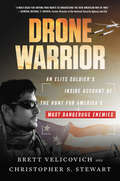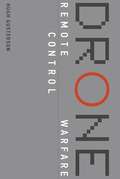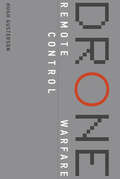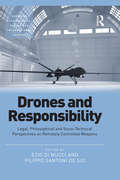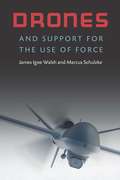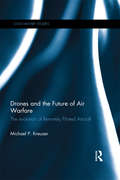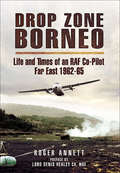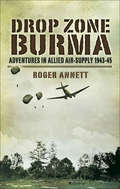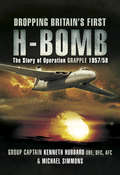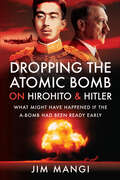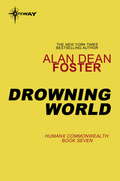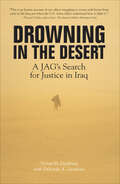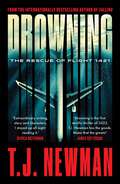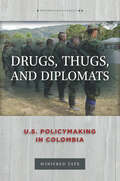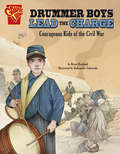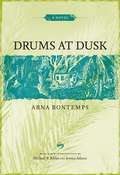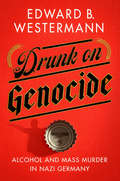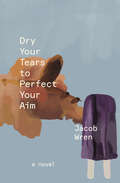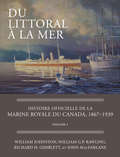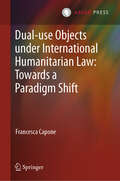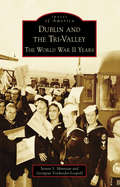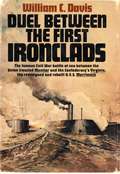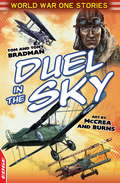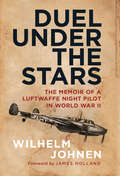- Table View
- List View
Drone Warrior: An Elite Soldier's Inside Account of the Hunt for America's Most Dangerous Enemies
by Christopher S. Stewart Brett VelicovichA former U.S. Army intelligence and special ops soldier gives a look inside some of the nation’s most secretive military operations.For nearly a decade, Brett Velicovich was at the center of America’s new generation of warfare: an arsenal of unmanned aerial vehicles—drones—taking down the world’s deadliest terrorists across the globe. Now this decorated veteran, with journalist Christopher S. Stewart, tells his story in a remarkable book packed with more classified drone operations cleared for public release than any other account ever published, according to the U.S. government. Drone Warrior offers an unprecedented view into the remarkably complex nature of drone missions in the hottest conflict zones today and the rigorous and wrenching on-the-ground decisions behind them.Drone Warrior also chronicles the U.S. military’s evolution in the past decade and the technology driving it. Velicovich considers the future it foretells, and speaks candidly on the physical and psychological toll it exacts, including the impact his missions had on his own life. He reminds us that while these machines can kill, they can also be used to preserve life, including protecting endangered species and supporting humanitarian operations—work he is engaged in today.
Drone Wars
by Peter L. Bergen Daniel RothenbergDrones are the iconic military technology of many of today's most pressing conflicts. Drones have captured the public imagination, partly because they project lethal force in a manner that challenges accepted norms and moral understandings. Drone Wars presents a series of essays by legal scholars, journalists, government officials, military analysts, social scientists, and foreign policy experts. It addresses drones' impact on the ground, how their use adheres to and challenges the laws of war, their relationship to complex policy challenges, and the ways they help us understand the future of war. The book is a diverse and comprehensive interdisciplinary perspective on drones that covers important debates on targeted killing and civilian casualties, presents key data on drone deployment, and offers new ideas on their historical development, significance, and impact on law and policy.
Drone: Remote Control Warfare
by Hugh GustersonDrones are changing the conduct of war. Deployed at presidential discretion, they can be used in regular war zones or to kill people in such countries as Yemen and Somalia, where the United States is not officially at war. Advocates say that drones are more precise than conventional bombers, allowing warfare with minimal civilian deaths while keeping American pilots out of harm's way. Critics say that drones are cowardly and that they often kill innocent civilians while terrorizing entire villages on the ground. In this book, Hugh Gusterson explores the significance of drone warfare from multiple perspectives, drawing on accounts by drone operators, victims of drone attacks, anti-drone activists, human rights activists, international lawyers, journalists, military thinkers, and academic experts. Gusterson examines the way drone warfare has created commuter warriors and redefined the space of the battlefield. He looks at the paradoxical mix of closeness and distance involved in remote killing: is it easier than killing someone on the physical battlefield if you have to watch onscreen? He suggests a new way of understanding the debate over civilian casualties of drone attacks. He maps "ethical slippage" over time in the Obama administration's targeting practices. And he contrasts Obama administration officials' legal justification of drone attacks with arguments by international lawyers and NGOs.
Drone: Remote Control Warfare
by Hugh GustersonDrone warfare described from the perspectives of drone operators, victims of drone attacks, anti-drone activists, international law, military thinkers, and others. Drones are changing the conduct of war. Deployed at presidential discretion, they can be used in regular war zones or to kill people in such countries as Yemen and Somalia, where the United States is not officially at war. Advocates say that drones are more precise than conventional bombers, allowing warfare with minimal civilian deaths while keeping American pilots out of harm's way. Critics say that drones are cowardly and that they often kill innocent civilians while terrorizing entire villages on the ground. In this book, Hugh Gusterson explores the significance of drone warfare from multiple perspectives, drawing on accounts by drone operators, victims of drone attacks, anti-drone activists, human rights activists, international lawyers, journalists, military thinkers, and academic experts.Gusterson examines the way drone warfare has created commuter warriors and redefined the space of the battlefield. He looks at the paradoxical mix of closeness and distance involved in remote killing: is it easier than killing someone on the physical battlefield if you have to watch onscreen? He suggests a new way of understanding the debate over civilian casualties of drone attacks. He maps “ethical slippage” over time in the Obama administration's targeting practices. And he contrasts Obama administration officials' legal justification of drone attacks with arguments by international lawyers and NGOs.
Drones and Responsibility: Legal, Philosophical and Socio-Technical Perspectives on Remotely Controlled Weapons (Emerging Technologies, Ethics and International Affairs)
by Ezio Di Nucci Filippo Santoni SioHow does the use of military drones affect the legal, political, and moral responsibility of different actors involved in their deployment and design? This volume offers a fresh contribution to the ethics of drone warfare by providing, for the first time, a systematic interdisciplinary discussion of different responsibility issues raised by military drones. The book discusses four main sets of questions: First, from a legal point of view, we analyse the ways in which the use of drones makes the attribution of criminal responsibility to individuals for war crimes more complicated and what adjustments may be required in international criminal law and in military practices to avoid ’responsibility gaps’ in warfare. From a moral and political perspective, the volume looks at the conditions under which the use of military drones by states is impermissible, permissible, or even obligatory and what the responsibilities of a state in the use of drones towards both its citizens and potential targets are. From a socio-technical perspective, what kind of new human machine interaction might (and should) drones bring and which new kinds of shared agency and responsibility? Finally, we ask how the use of drones changes our conception of agency and responsibility. The book will be of interest to scholars and students in (military) ethics and to those in law, politics and the military involved in the design, deployment and evaluation of military drones.
Drones and Support for the Use of Force
by Marcus Schulzke James Igoe WalshCombat drones are transforming attitudes about the use of military force. Military casualties and the costs of conflict sap public support for war and for political and military leaders. Combat drones offer an unprecedented ability to reduce these costs by increasing accuracy, reducing the risks to civilians, and protecting military personnel from harm. These advantages should make drone strikes more popular than operations involving ground troops. Yet many critics believe drone warfare will make political leaders too willing to authorize wars, weakening constraints on the use of force. Because combat drones are relatively new, these arguments have been based on anecdotes, a handful of public opinion polls, or theoretical speculation. Drones and Support for the Use of Force uses experimental research to analyze the effects of combat drones on Americans’ support for the use of force. The authors’ findings—that drones have had important but nuanced effects on support for the use of force—have implications for democratic control of military action and civil-military relations and provide insight into how the proliferation of military technologies influences foreign policy.
Drones and the Future of Air Warfare: The Evolution of Remotely Piloted Aircraft (Cass Military Studies)
by Michael P. KreuzerThis book examines the evolution of airpower and specifically the growth and proliferation of Remotely Piloted Aircraft (RPAs). While most existing literature examines either the law or ethics of RPAs, and some newer scholarship looks to the battlefield effectiveness (the gains from strikes versus the potential for ‘blowback, etc.), this work investigates it from a broader military perspective. It examines the strategy for employment of RPAs across the spectrum of warfare, the potential deterrent value of RPAs in some circumstances, and the resulting ability of RPAs to fundamentally shift the character of when and how wars are fought. The central aim of this book is to evaluate the role of ‘drones’ in warfare to date, and make basic projections on how states will adopt RPAs and UCAVs in the future. At the core is the goal of answering a broad, underlying research question: How will the RPA innovation impact military strategy and international security? This book will be of much interest to students of airpower, drone warfare, military and strategic studies, security studies and IR.
Drop Zone Borneo: Life and Times of an RAF Co-Pilot Far East, 1962-65
by Roger AnnettIn 1963 the Indonesian Army that threatened Borneo numbered 330,000 men, plus three thousand Commandos. Of these, six thousand were within 20 miles of the Borneo frontier. This grew to thirteen thousand in early 1965. From mid-way through 1964, British troops and their allies who were defending the border started to make offensive incursions into Indonesian Borneo—these operations were codenamed "Claret". Taken into account the confrontational nature of the campaign, casualties sustained in Borneo were surprisingly light. That in the whole of the Borneo campaign there were no fatalities among the RAF supply-dropping transports was extraordinary. The border area between the Indonesian and Malaysian parts of Borneo was one of the most inaccessible areas of mountainous jungle anywhere in the world—an entire army was kept supplied in the field for the complete campaign. This is the exciting account from a pilot who flew the dangerous flying missions and relates the tenseness and stresses of Jungle life in those dangerous days.
Drop Zone Burma: Adventures in Allied Air-Supply, 1943–45
by Roger AnnettAir-dropped supplies were a vital part of the Allied campaign in Burma during World War II. The transportation of munitions, food and medical supplies was undertaken in the most difficult situations, both on the land where the air bases were often situated in remote tropical jungle terrain and in the air when hazardous flying conditions were met in the steamy airs above the carpet of forest treetops.This book is based upon the memories of nine veterans of the campaign: John Hart, an air-dispatcher with 194 Squadron; Peter Bray, a Dakota pilot with 31 Squadron; Arthur Watts, a fitter with both 31 and 194 Squadrons; Colin Lynch an Observer on 31 Squadron; Norman Currell, a Dakota pilot with 31 Squadron; George Hufflett, 1st Queens Infantry; Ken Brown, Royal Signals; Eric Knowles, the Buffs and Dame Vera Lynn who was with ENSA during the campaign. It describes how they arrived in Burma and their previous wartime experiences and then explains there parts in the famous actions such as The Defence of Arakan, The Sieges of Imphal and Kohima, the Allied Counterattack, the Advance to Mandalay and the Race to Rangoon.The author explains the background to this theater of war and then puts the veterans memories into context as the campaign progresses.
Dropping Britain's First H-Bomb: The Story of Operation GRAPPLE, 1957/58
by Michael Simmons Kenneth HubbardOn 15 May 1957 Vickers Valiant V-Bomber X.D.818 under the command of Wg. Cdr. Kenneth Hubbard, O.C. 49 Squadron R.A.F., dropped Britains first live thermonuclear bomb. The success of Operation Grapple broadcast to the world that the UK had the resolve and the capability to protect her own democracy and that of her Commonwealth. It was a major breakthrough that ensured Britain maintained her place in the most senior influential positions of the United Nations and other corridors of world power, and in the ensuing years provide Britains deterrent throughout the decades of the Cold War.The theme of this book is to explain how the R.A.F. selected and trained the crews who would be responsible for the precision dropping of the several weapons that would detonate during Grapple. It also provides a complete background to the parts played by all other services during this unique period in British history.
Dropping the Atomic Bomb on Hirohito & Hitler: What Might Have Happened if the A-Bomb Had Been Ready Early
by Jim MangiOn 2 August 1939, the renowned theoretical physicist Albert Einstein wrote a letter to President Roosevelt in which he declared that ‘it might become possible to set up a nuclear chain reaction in a large mass of uranium’. He went on to declare that ‘extremely powerful bombs of a new type may thus be constructed’. Shortly after Japan’s attack on Pearl Harbor, Congress allocated substantial funds to allow research to be undertaken to follow through on Einstein’s idea and build an atomic bomb. Few, if any, could have imagined what they had agreed to support. But what if actual events had taken a different course? The First Atomic Bomb: An Alternate History to the Ending of WW2 is a highly accurate, thoroughly researched, alternative history presenting a narrative of events exploring what might have happened if the atom bomb had been available somewhat earlier than it really was. What if the atomic bomb had been ready for deployment in, say, February 1945? Had the atomic bomb been ready sooner, how would this have affected the war in Europe, and in particular Germany’s surrender? What would the impact have been in the war in the Pacific against Imperial Japan, and how would the Soviets have reacted? And what would the following Cold War have looked like? These are all questions and scenarios that the author rigorously examines. Solidly based on real people and actual events, in this book James Mangi describes the Manhattan Project to build the atom bomb getting an earlier start after President Roosevelt appointed an energetic scientist, Walter Mendenhall, to study the feasibility of the bomb, instead of the more traditional bureaucrat, Lyman Briggs, he actually chose. This scenario, he reveals, might well have produced a war-ending atomic bomb earlier, the effects of which rippled through the post-war world.
Drowning World
by Alan Dean FosterThe Humanx Commonwealth: Book Seven.They call it the Drowning World. It is Fluva, a planet on the fringes of the Commonwealth where it rains torrentially, ceaselessly, and maddeningly for all but one month of the Fluvan year. Chief Administrator Lauren Matthias is fairly new to the position. Her primary goal: keeping Fluva's indigenous species, the warlike Sakuntala, and its immigrant species, the timid but hardworking Deyzara, from annihilating one another. The wettest place on Fluva is Viisiiviisii, an immense, mostly unexplored jungle. Thanks to the endless rains and humid conditions, exotic animals and plants have thrived there, many of them deadly predators. Yet the same evolutionary process responsible for creating toxic creatures has made the jungle a treasure trove of undiscovered botanicals potentially useful in engineering everything from pharmaceuticals to perfumes. A man can get rich there. Or die trying. Bio-prospector Sadrach Hasselemoga has come to the jungle to get rich - if he survives the terrain once his sabotaged ship goes down. When a Sakuntala and a Deyzara are dispatched by Matthias to rescue the unfortunate soul, their ship crashes, too. Now, in order to survive, the three unlikely allies must do something that no one has ever done before: walk out of the Viisiiviisii. Meanwhile, in what passes for civilization, long-simmering tensions between Sakuntala and Deyzara erupt into violence, threatening Matthias's official position of neutrality - and her life. Behind the violence, Matthias detects a mysterious presence, one related to Shadrach's disappearance. But how are the two related? The answer, when it comes, will send shock waves through the entire Commonwealth...and beyond.
Drowning in the Desert: A JAG's Search for Justice in Iraq
by Vivian H. Gembara Deborah A. GembaraSeveral people are waiting to greet Captain Vivian Gembara when she returns home after a year-long tour of duty in Iraq--her grateful fiancŠ and two officers dispatched from headquarters to retrieve "the file." Certainly not the homecoming she expected, but such is life when you are in the business of soldiers behaving badly. As a lawyer for the U.S. Army, Vivian counsels them, investigates them, and when necessary, prosecutes them. When an Iraqi teenagers body is found floating in the Tigris River and U.S. soldiers are believed to have been involved, she knows she has a case on her hands. What she doesn't realize is just how much that case will reveal about the Armys conduct at war.Drowning in the Desert:A JAG's Search for Justice in Iraq is both a legal thriller and a searing account of the savagery that occurs when commanders place "the fight" above all else.
Drowning: the most thrilling blockbuster of the year
by T. J. NewmanFlight attendant turned New York Times bestselling author T. J. Newman - whose first book Falling was an instant international bestseller and the biggest thriller debut of 2021 - returns for her second book, an edge-of-your-seat thriller about a commercial jetliner that crashes into the ocean, and sinks to the bottom with passengers trapped inside, and the extraordinary rescue operation to save them.Six minutes after takeoff, Flight 1421 crashes into the Pacific Ocean. During the evacuation, an engine explodes and the plane is flooded. Those still alive are forced to close the doors—but it&’s too late. The plane sinks to the bottom with twelve passengers trapped inside. More than two hundred feet below the surface, engineer Will Kent and his eleven-year-old daughter Shannon are waist-deep in water and fighting for their lives. Their only chance at survival is an elite rescue team on the surface led by professional diver Chris Kent - Shannon&’s mother and Will&’s soon-to-be ex-wife - who must work together with Will to find a way to save their daughter and rescue the passengers from the sealed airplane, which is now teetering on the edge of an undersea cliff.There&’s not much time. There&’s even less air.With devastating emotional power and heart-stopping suspense, Drowning is an unforgettable thriller about a family&’s desperate fight to save themselves and the people trapped with them - against impossible odds.Praise for Drowning: 'Stunning, emotional, and unforgettable. Drowning reads like Apollo 13 underwater' Don Winslow, New York Times bestselling author of City on Fire and The Border 'Drowning is The Poseidon Adventure meets The Martian. It is another can&’t-put-down, edge-of-your-seat thriller from T. J. Newman, one of our most exciting new authors' Adrian McKinty, New York Times bestselling author of The Chain and The Island 'Drowning is pure adrenaline and all heart. Gripping, relentless, effortlessly assured, T. J. Newman&’s thriller is tense and moving. You&’ll be grabbed from page one as the crew and passengers of a downed airliner fight for survival and rescuers race to reach them. Drowning is an incredible ride - strap in, brace, and remember to breathe' Meg Gardiner, #1 New York Times bestselling author
Drugs, Thugs, and Diplomats: U.S. Policymaking in Colombia
by Winifred TateIn 2000, the U. S. passed a major aid package that was going to help Colombia do it all: cut drug trafficking, defeat leftist guerrillas, support peace, and build democracy. More than 80% of the assistance, however, was military aid, at a time when the Colombian security forces were linked to abusive, drug-trafficking paramilitary forces. Drugs, Thugs, and Diplomats examines the U. S. policymaking process in the design, implementation, and consequences of Plan Colombia, as the aid package came to be known. Winifred Tate explores the rhetoric and practice of foreign policy by the U. S. State Department, the Pentagon, Congress, and the U. S. military Southern Command. Tate's ethnography uncovers how policymakers' utopian visions and emotional entanglements play a profound role in their efforts to orchestrate and impose social transformation abroad. She argues that U. S. officials' zero tolerance for illegal drugs provided the ideological architecture for the subsequent militarization of domestic drug policy abroad. The U. S. also ignored Colombian state complicity with paramilitary brutality, presenting them as evidence of an absent state and the authentic expression of a frustrated middle class. For rural residents of Colombia living under paramilitary dominion, these denials circulated as a form of state terror. Tate's analysis examines how oppositional activists and the policy's targets--civilians and local state officials in southern Colombia--attempted to shape aid design and delivery, revealing the process and effects of human rights policymaking.
Drummer Boys Lead the Charge: Courageous Kids of the Civil War (Courageous Kids)
by Bruce BerglundIn the early 1860s, the United States is torn apart by Civil War. The conflict between the North and the South affects everyone, including many boys who want to join in the fight. Among them are young Edward Black, Lyston and Orion Howe, and Charles Moore. They're too young to fight in combat, but they show their courage by marching to battle as drummer boys. Like any other soldiers in the war, they risk being wounded, captured, or killed in action. But in spite of the risk, these courageous boys bravely face the dangers of war to help fight for their country.
Drums At Dusk
by Arna Bontemps Michael P. Bibler Jessica AdamsA story of love, violence, and race set at the outbreak of the Haitian Revolution in 1791, African American writer Arna Bontemps's Drums at Dusk immerses readers in the opulent and brutal -- yet also very fragile -- society of France's richest colony, Saint Domingue. First published in 1939, this novel explores the complex web of tensions connecting wealthy plantation owners, poor whites, free people of color, and the slaves who stunned the colony and the globe by uniting in a carefully planned uprising. The novel's hero, Diron Desautels, a white Creole born in Saint Domingue who belongs to the French antislavery group Société des Amis des Noirs, attempts to spread his message of "liberty, equality, fraternity" in a world fraught with conflict.
Drunk on Genocide: Alcohol and Mass Murder in Nazi Germany (Battlegrounds: Cornell Studies in Military History)
by Edward B. WestermannIn Drunk on Genocide, Edward B. Westermann reveals how, over the course of the Third Reich, scenes involving alcohol consumption and revelry among the SS and police became a routine part of rituals of humiliation in the camps, ghettos, and killing fields of Eastern Europe. Westermann draws on a vast range of newly unearthed material to explore how alcohol consumption served as a literal and metaphorical lubricant for mass murder. It facilitated "performative masculinity," expressly linked to physical or sexual violence. Such inebriated exhibitions extended from meetings of top Nazi officials to the rank and file, celebrating at the grave sites of their victims. Westermann argues that, contrary to the common misconception of the SS and police as stone-cold killers, they were, in fact, intoxicated with the act of murder itself. Drunk on Genocide highlights the intersections of masculinity, drinking ritual, sexual violence, and mass murder to expose the role of alcohol and celebratory ritual in the Nazi genocide of European Jews. Its surprising and disturbing findings offer a new perspective on the mindset, motivation, and mentality of killers as they prepared for, and participated in, mass extermination.Published in Association with the US Holocaust Memorial Museum.
Dry Your Tears to Perfect Your Aim
by Jacob WrenWhat are the best ways to support political struggles that aren’t your own? What are the fundamental principles of a utopia during war? Can we transcend the societal values we inherit? Dry Your Tears to Perfect Your Aim is a remarkably original, literary page-turner that explores such pressing questions of our time.A depressed writer visits a war zone. He knows it’s a bad idea, but his curiosity and obsession that his tax dollars help to pay for foreign wars draw him there. Amid the fighting, he stumbles into a small strip of land that’s being reimagined as a grassroots, feminist, egalitarian utopia. As he learns about the principles of the collective, he moves between a fragile sense of self and the ethical considerations of writing about what he experiences but cannot truly fathom. Meanwhile, women in his life—from this reimagined society and elsewhere—underscore truths hidden in plain sight. In these pages, real-world politics mingle with profoundly inventive fabulations. This is an anti-war novel unlike any other, an intricate study of our complicity in violent global systems and a celebration of the hope that underpins the resistance against them.
Du littoral à la mer: Histoire officielle de la Marine royale du Canada, 1867–1939
by William Johnston Richard H. Gimblett William G.P. Rawling John MacFarlaneLa création de la Marine royale du Canada (MRC) en 1910 et ses premières années d’existence ont été marquées par un débat politique quant à la nécessité d’un service naval au Canada. Du littoral à la mer, le premier d’une série de trois volumes relatant l’histoire officielle de la MRC, retrace les trois premières décennies de la Marine, de ses débuts comme marine de pacotille établie par le Premier ministre sir Wilfrid Laurier et constituée de deux croiseurs britanniques obsolètes jusqu’ à son entrée dans la Seconde Guerre mondiale, en tant que force composée de six destroyers modernes et de quatre dragueurs de mines. L’histoire de la MRC au cours du conflit de 1939-1945 a déjà été raconté dans la partie 1, Rien de plus noble, et la partie 2, Parmi les puissances navales, du volume II de la série, publié précédemment. Fondé sur des recherches archivistiques approfondies, l’ouvrage Du littoral à la mer relate les âpres débats qui ont finalement mené à l’établissement de la MRC en 1910, son existence précaire après le remplacement soudain du gouvernement de Laurier par celui de Robert Borden un an plus tard, ainsi que les difficultés de la Marine au cours de la Première Guerre mondiale lorsqu’elle a dû défendre les eaux canadiennes avec très peu de ressources. Des conséquences désastreuses de la terrible explosion survenue Halifax en décembre 1917 jusqu’à la campagne menée par les sous-marins allemands au large de la côte Est du Canada en 1918, le volume I examine dans quelle mesure les conseils souvent incohérents qu’Ottawa recevait de l’Amirauté britannique, à Londres, ont compliqué la tâche de la MRC. La dernière section de cet important ouvrage historique bien illustré traite de l’expérience de la MRC pendant l’entre-deux-guerres, alors que le sentiment antiguerre et une dépression économique menaçaient sa survie même.
Dual-use Objects under International Humanitarian Law: Towards a Paradigm Shift
by Francesca CaponeThis book deals with a crucial and yet under-explored topic that has increasingly gained momentum during modern armed conflicts, i.e. dual-use objects under international humanitarian law (IHL). Dual-use objects, such as energy infrastructures, water installations and civilian means of transportation and communication, which could be used also for military purposes, is a term that has entered the IHL jargon but has not attained the status of a legal concept. Dual-use objects are easily identifiable and yet remain difficult to pin down, in particular when it comes to separating them from military objectives and determining the applicable rules to enhance their protection. Although attacks against critical infrastructures are traditionally justified as being part of a legitimate military strategy, experts and, in some instances, governments are uncomfortable with the idea of depriving the civilian population of services and goods essential to its survival. Yet, the sense of discomfort has not led to any significant improvement and &‘dual-use objects&’ remain on the target lists of most belligerents. A number of factors, which this book analyses to explain the rise and rationale behind the current 'mainstream approach' to dual-use objects, contributed to cementing the status quo. The present book, building on these premises, pursues a twofold aim. First, this book seeks to fill a significant gap in the IHL scholarship in light of the limited attention that the topic has received so far. Second, this book aims to challenge the mainstream approach through a rigorous inquiry and the development of a new paradigm. The paradigm shift, which is at the heart of this study, places under the spotlight the civilian function of dual-use objects and reclaim the central role of the individual actors that plan, order and execute attacks against these targets. This book aspires to become an essential tool for academics and practitioners working in the IHL field, but at the same time its readership is expected to include students at all levels that have an interest in the topic and seeks to approach it in an innovative way. Francesca Capone is Associate Professor of International Law at the Institute DIRPOLIS of the Scuola Superiore Sant&’Anna in Pisa, Italy.
Dublin and the Tri-Valley: The World War II Years (Images of America)
by Steven S. Minniear Georgean Vonheeder-LeopoldIn 1941, the Navy sought West Coast locations for bases to ship men, material, and equipment into World War II's Pacific theater. The Dublin and Livermore area offered wide-open spaces with good transportation routes to the San Francisco Bay area. Near Dublin, the Navy built Camp Parks, Camp Shoemaker, and Shoemaker Naval Hospital. Camp Parks prepared Seabees to build and maintain airfields, ports, and hospitals from Guadalcanal to Japan. Hundreds of thousands of other sailors and WAVES came to Camp Shoemaker on their way from basic training to postings on ships, bases, and stations throughout the Pacific. Shoemaker Hospital saw them again when they returned injured or ill. Farther east, the Navy built Livermore Naval Air Station to train thousands to fly.
Duel Between the First Ironclads
by William C. DavisOn March 9, 1862, an epic naval encounter in Hampton Roads, Virginia, changed the face Of warfare on the water for all time, The Monitor met the Virginia (Merrimack) and their story entered the realm of history and legend. Copyright © Libri GmbH. All rights reserved.
Duel In The Sky (EDGE: World War One Short Stories #1)
by Tony BradmanA new German fighter ace is terrorising British planes over the trenches of France. It will take the bravery and sacrifice of a Britsh ace and the courage of a hero to bring him down.This title is published by Franklin Watts EDGE, which produces a range of books to get children reading with confidence. EDGE - for books kids can't put down.
Duel Under the Stars: The Memoir of a Luftwaffe Night Pilot in World War II
by Wilhelm Johnen"The enemy bomber grew larger in my sights and the rear gunner was sprayed by my guns just as he opened fire. The rest was merely a matter of seconds. The bomber fell like a stone out of the sky and exploded on the ground. The nightmare came to an end."In this enthralling memoir, the author recounts his experiences of the war years and traces the story of the ace fighter pilots from the German development of radar to the Battle of Britain.Johnen flew his first operational mission in July 1941, having completed his blind-flying training. In his first couple of years he brought down two enemy planes. The tally went up rapidly once the air war was escalated in spring 1943, when Air Marshal Arthur Harris of the RAF Bomber Command began the campaign dubbed the Battle of the Ruhr.During this phase of the war Johnens successes were achieved against a 710-strong force of bombers. Johnens further successes during Harriss subsequent Berlin offensive led to his promotion as Staffelkapitan (squadron leader) of Nachtjagdgeschwader and a move to Mainz. During a sortie from there, his Bf 110 was hit by return fire and he was forced to land in Switzerland. He and his crew were interned by the authorities. The Germans were deeply worried about leaving a sophisticatedly equipped night fighter and its important air crew in the hands of a foreign government, even if it was a neutral one. After negotiations involving Gring, the prisoners were released.Johnens unit moved to Hungary and by October 1944 his score was standing at 33 aerial kills. His final one came in March the following year, once Johnen had moved back to Germany.
